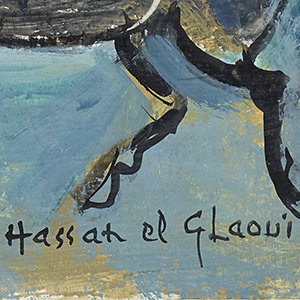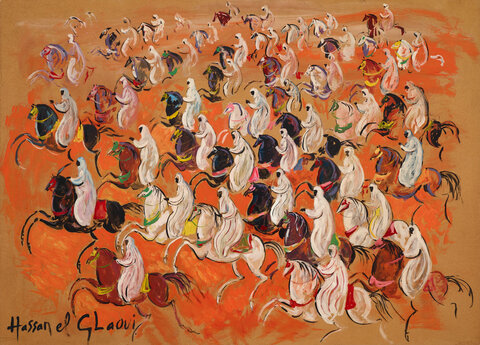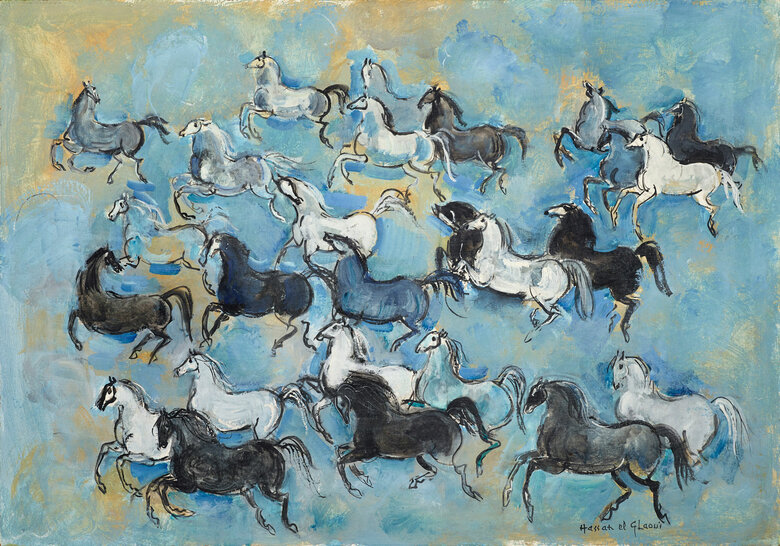Born in 1923 in Marrakesh, Hassan El Glaoui descended from a prominent family of the oldest Berber tribes of the High Atlas Mountains. His father, Thami El Glaoui (1879-1956), was the Pasha of...


HASSAN EL GLAOUI, Morocco (1924 - 2018)
Bio
Written by ARTHUR DEBSI
Born in 1923 in Marrakesh, Hassan El Glaoui descended from a prominent family of the oldest Berber tribes of the High Atlas Mountains. His father, Thami El Glaoui (1879-1956), was the Pasha of the city from 1912 to 1956, and his mother, Lalla Zineb al Muqri, was the daughter of Muhammad al Muqri (1851-1957), grand vizier for Moroccan sultans. This powerful family affiliation consequently didn’t predestine the young El Gloui to follow an artistic career. He received a French quality education, enrolling at the Lycée Lyautey in Casablanca in 1938, before moving back to his hometown, where he studied at the Lycée Mangin during World War II. Under the French protectorate, Marrakesh was a cosmopolitan city, attracting people from all around the world, and Thami El Glaoui (1879-1956) used to invite important personalities from the European social elite. The beginnings of the artist’s journey specifically started with some several encounters with these visitors. In 1943, Winston Churchill (1874-1965) was sick, while conducting missions in North Africa, and decided to spend time in Marrakesh to convalesce from pneumonia[1]. He visited Thami El Glaoui (1879-1956), and discovered some sketches drawn by the son of the Pasha. Painting in his spare time, the British Prime Minister was truly captivated by the precocious talent of Hassan El Glaoui, to the extent that he highly advised the father to support his son to study art[2]. Later, El Glaoui would even say that he had always been thankful to Winston Churchill (1874-1965) for this encouragement[3]. In 1950, the American actor Edward Robinson (1893-1973), and his wife Gladys Lloyd (1895-1971), painter and art collector, as well as Anson Conger Goodyear (1877-1964), the first president of the Museum of Modern Art in New York; also visited El Glaoui’s family. All of them were very impressed by the works of Hassan El Glaoui, and they in turn contributed to change the strict position of the father. The same year, the painter traveled to France, where he started studying at the École Nationale Supérieure des Beaux-Arts. He trained in drawing and oil painting under the supervision of the French painter Jean Souverbie (1891-1981), and attended the atelier of Émilie Charmy (1877-1974). A year later, he exhibited some works alongside Gladys Lloyd (1895-1971) in Paris at Galerie André Weil, and at Wildenstein Gallery in New York in 1952. After a lifetime in France, Hassan El Glaoui returned to Morocco, and mainly produced portraits, namely of his second wife, Christine Legendre, and even King Hassan II (1929-1999).
In the late 1940s, Hassan El Glaoui liked to paint people from his surrounding such as the gardener, his sister, and progressively executed landscapes, and still lifes. Despite the fact that he was living in Morocco, he manifested certain knowledge in modern French painting, and technique. In some of these early works, the treatment of the colors somehow reminds the Fauvism movement, and some plein-air paintings demonstrate an impressionist touch[4]. However, one of the typical themes of his oeuvre remains the scenes inherent to the Moroccan equestrian tradition, seen in the two non-dated pieces Chevaux Galopant, and Cavalcade, both part of the Dalloul Art Foundation’s collection. In the Arab-Islamic history, the horse and its role, had fundamentally been involved in the military field; and the development of the cavalry became a discipline, which needs theoretical, and practical skills in horsemanship, including for instance, the techniques of riding, and veterinary knowledge. Inherited from the 3rd century, this versatile discipline is referred to as the Arabic word, ‘furusiyya’, and has supplied various treaties, scientific, and military[5]. Therefore, the horse was associated to the leaders, who raised it for competitions, or to strengthen diplomatic, and social relationships, by offering it as a gift[6].
Since his father possessed stables, the horse had always belonged to the family environment, in which Hassan El Gloui grew up. He quickly showed a fascination for the animal, and bought his first horse with his pocket money at the age of 9 [7].
There is no doubt that Hassan El Glaoui largely got inspiration from his childhood, and some events, which marked his memory: ‘My love of my country has been the defining spirit of my painting. I have recorded our ancestral roots, the flowers in the Valley of the Kasbah and the red Cherifian palaces, the royal courteges with their long lines of white burnouses and the mounted cavalry and their horses’[8]. The harkas – punitive expeditions –, that his father sometimes joined[9], were a recurrent theme, that the painter illustrated, as well as the tbourida, also called ‘fantasia’. The latter is the reconstitution of a military assault of Arab, or Berber horsemen, accompanying some festivities in the Maghreb region. In the artwork entitled Cavalcade, El Glaoui depicted a group of black men, dressed with white Moroccan djellabas, and riding horses to an unknown destination. He employed a palette of warm colors such as orange, yellow, and ochre, which recall the colors of the mountainous landscapes of Morocco. Yet, even though he reproduced images similar to the ones, which he had seen before, the artist preferred to give an emotional aspect to the moments, rather than an Orientalist vision. Detached from a faithful representation of the reality, and using thin brushstrokes, he reduced the silhouette of the men, and the horses, to simple lines, and almost abstracted shapes. El Glaoui perfectly rendered the feeling of motion emanating from the race, by repeating the curving lines, which created a dynamic rhythm to the composition. The painter took liberty in his way to represent the subjects, and turned them into a dreamlike world. Here, the ensemble looks like a parietal painting, and the characters seem to be floating. In the second example Chevaux Galopant, he colored in blue some of the horses, as if this were the product of a child’s imagination.
Although Hassan El Glaoui is famous for this artistic passion for the horse, he tackled a wide range of topics. In the 1980s, he returned to the practice of the portraits, and heard about a circus, which occurred in Muhammad V National Theatre. He waited for the end of the show, to be able to portray a series of the harlequins, and clowns. Throughout his oeuvre, El Glaoui captured instants of his life, tinted of nostalgia, which are also the testimony of the history of modern Morocco, and its rich culture.
Hassan El Glaoui passed away in 2018 in Rabat.
Notes
[1] Nicholas, Herbert G. “Leadership during World War II,” March 5, 2020. [2] El" class="redactor-autoparser-object">https://www.britannica.com/bio... Glaoui, T., & Sandys, C. (2013, April 01). Meetings in Marrakech: The Paintings of Hassan El Glaoui and Winston Churchill. Retrieved August 18, 2020, from https://winstonchurchill.org/publications/finest-hour/finest-hour-155/meetings-in-marrakech-the-paintings-of-hassan-el-glaoui-and-winston-churchill/
[3] Sasportas, V. (2014, December 04). Hassan El Glaoui : "Je suis devenu peintre grâce à Churchill". Retrieved August 19, 2020, from https://www.lefigaro.fr/arts-expositions/2014/12/04/03015-20141204ARTFIG00039-hassan-el-glaoui-je-suis-devenu-peintre-grace-a-churchill.php
[4] Boushaba, Amine. “Expo: Hassan El Glaoui, Des Chevaux, Mais Pas Seulement,” April 5, 2019. https://leconomiste.com/article/1043266-expo-hassan-el-glaoui-des-chevaux-mais-pas-seulement.
[5] Zouache, Abbes. “Une Culture En Partage : La Furūsiyya à l’Épreuve Du Temps,” September 30, 2013. https://journals.openedition.org/medievales/6953#quotation.
[6] Schiettecatte, Jérémie, and Abbes Zouache. “The Horse in Arabia and the Arabian Horse: Origins, Myths and Realities,” June 30, 2017. https://journals.openedition.org/cy/3280?lang=en.
[7] Jadraoui, Siham. “Attijariwafa Bank Célèbre Les 60 Ans De Peinture De Hassan El Glaoui.” Aujourd'hui Le Maroc, 2010. [8] Hassan" class="redactor-autoparser-object">https://aujourdhui.ma/culture/... El Glaoui in an interview carried by Yacout in 2009, quoted in Merzaban, Daliah. Caravan = Al-Qāfilah. Sharjah, United Arab Emirates, UAE: Barjeel Art Foundation, 2012. [P.54]
[9] https://www.youtube.com/watch?v=MF4dfnPtc9s
Sources
Ali, Wijdan. Modern Islamic Art: Development and Continuity. Gainesville, USA: University Press of Florida, 1997.
Aroussi, Moulim el., and Brahim Alaoui. Peinture Marocaine 1950-2010: Collection Elisabeth Bauchet-Bouhlal. Marrakech, Morocco: ES-SAADI Garden & Resort, 2010.
Boushaba, Amine. “Expo: Hassan El Glaoui, Des Chevaux, Mais Pas Seulement,” April 5, 2019. https://leconomiste.com/article/1043266-expo-hassan-el-glaoui-des-chevaux-mais-pas-seulement.
Goldenberg, André. “1956 - 1986 : Trente Ans De Peinture Marocaine.” Cahiers De La Méditerranée, 1989.
Jadraoui, Siham. “Attijariwafa Bank Célèbre Les 60 Ans De Peinture De Hassan El Glaoui.” Aujourd'hui Le Maroc, 2010. https://aujourdhui.ma/culture/attijariwafa-bank-celebre-les-60-ans-de-peinture-de-hassan-el-glaoui-73477.
Merzaban, Daliah. Caravan = Al-Qāfilah. Sharjah, United Arab Emirates, UAE: Barjeel Art Foundation, 2012.
Nicholas, Herbert G. “Leadership during World War II,” March 5, 2020. https://www.britannica.com/biography/Winston-Churchill/Leadership-during-World-War-II.
Schiettecatte, Jérémie, and Abbes Zouache. “The Horse in Arabia and the Arabian Horse: Origins, Myths and Realities,” June 30, 2017.
https://journals.openedition.org/cy/3280?lang=en.
Shapiro, Gene. “Antiques Roadshow.” PBS. Public Broadcasting Service, 2020. https://www.pbs.org/wgbh/roadshow/stories/articles/2020/4/13/hassan-el-glaoui/.
Zouache, Abbes. “Une Culture En Partage : La Furūsiyya à l’Épreuve Du Temps,” September 30, 2013. https://journals.openedition.org/medievales/6953#quotation.
“Hommage à Hassan El Glaoui, Regard Sur 50 Ans De Son Parcours Artistique.” Accessed 2020. http://www.memoarts.ma/expo/expo/45.pdf.
Sotheby's. “Moroccan Master Hassan El Glaoui Remembered by His Daughter Touria, Founder of 1-54 Contemporary African Art Fair,” February 22, 2019. https://www.sothebys.com/en/articles/moroccan-master-hassan-el-glaoui-remembered-by-his-daughter-touria-founder-of-1-54-contemporary-african-art-fair.
CV
Selected Solo Exhibitions
2019
Le Sel de Ma Terre, Musée Mohammed VI d’Art Moderne et Contemporain, Rabat, Morocco
2018
Hommage à Hassan El Glaoui, Galerie Dar El Bacha, Marrakech, Morocco
2010
Rétrospective, 60 Ans de Peinture, Attijariwafa Bank, Casablanca, Morocco
2009
Pacha de l’Art, Galerie Rempart, Marrakech, Morocco
2005
Matisse Art Gallery, Marrakech, Morocco
1976
Hammer Galleries, New York, United States of America
1975
Galerie V, Paris, France
1969
Galerie Isy Brachot, Brussels, Belgium
Tryon Gallery, London, United Kingdom
Centre Culturel International, Hammamet, Tunisia
1968
Upper Grosvenor Galleries, London, United Kingdom
1967
Hammer Galleries, New York, United States of America
1965
Galerie Pierre Carrez, Paris, France
1964
Galerie Jean Berthier, Marseille, France
1963
Galerie Jeanne Castel, Paris, France
1960
Ohana Gallery, London, United Kingdom
1951
Wildenstein Gallery, New York, United States of America
Galerie André Weil, Paris, France
Selected Group Exhibitions
2022
Our Land Just Like a Dream, Musée d'Art Contemporain Africain Al Maaden, Marrakech, Morocco
2020
Welcome Home Vol. II, MACAAL, Museum of African Contemporary Art Al Maaden, Marrakech, Morocco
2017
E-Mois, Autobiographie d’une collection, MACAAL, Marrakech, Morocco
The 10th Edition of Le Salon du Cheval, El Jadida, Rabat, Morocco
2016
The 9th Edition of Le Salon du Cheval, El Jadida, Rabat, Morocco
2014
Rencontre à Marrakech: Peintures de Sir Winston Churchill et Monsieur Hassan El Glaoui, La Mamounia, Marrakech, Morocco
2012
Meetings in Marrakech: Paintings of Hassan El Glaoui and Winston Churchill, Leighton House Museum, London, United Kingdom
The 5th Edition of Le Salon du Cheval, El Jadida, Marrakech, Morocco
2011
Caravan, Barjeel Art Foundation, Sharjah, United Arab Emirates
2009
The 3rd Edition Arts in Marrakech, Marrakech, Morocco
2008
–2010
Le Salon du Cheval, El Jadida, Rabat, Morocco
1999
Matisse Art Gallery, Marrakech, Morocco
1988
29 Paintings from Morocco, The National Cultural Centre, Cairo, Egypt
1966
Festival Mondial des Arts Nègres, Dakar, Senegal
1963
Rencontre internationale des artistes, Musée des Oudayas, Rabat, Morocco
Collections
Musée Mohammed VI d’Art Moderne et Contemporain, Rabat, Morocco
The Barjeel Art Foundation, Sharjah, United Arab Emirates
The Ramzi and Saeda Dalloul Art Foundation, Beirut, Lebanon
Press
LeFigaro.pdf
Meetings in Marrakech_ The Paintings of Hassan El Glaoui and Winston Churchill - The International Churchill Society.pdf
مغرس _ لندن تستضيف معرضا مشتركا للوحات حسن الكلاوي وونستون تشرشل.pdf
Alquds Newspaper.pdf
معرضالفرس والتبوريدة برواق مرسم 2 - جريدة الصباح.pdf
لقاء فني في مراكش بين حسن الكلاوي وونستون تشرشل.pdf
تنوع الأساليب وتعدد الأجيال وبقاء الفرس سيداً AZZAMAN الزمان.pdf
نشأة الفن المعاصر المغربي - مشاهد 24.pdf
TheNational.pdf
Hassan El Glaoui _ Barjeel Art Foundation.pdf
Brian El Glaoui Bexter _ _Hassan El Glaoui avait un style bien à lui_ _ VH Magazine.pdf
Remembering Hassan El Glaoui_ the Moroccan artist who was encouraged to paint by Winston Churchill.pdf
Le top 8 des oeuvres marocaines les plus chères _ Telquel.ma.pdf
HASSAN EL GLAOUI Artwork
Become a Member
Join us in our endless discovery of modern and contemporary Arab art
Become a Member
Get updates from DAF
Follow Artists
Save your favourite Artworks
Share your perspectives on Artworks
Be part of our community
It's Free!
We value your privacy
TermsCookiesPrivacy Policies
Become a Member
Get updates from DAF
Follow Artists
Save your favourite Artworks
Share your perspectives on Artworks
Be part of our community
It's Free!
We value your privacy
TermsCookiesPrivacy Policies
Become a Member
Get updates from DAF
Follow Artists
Save your favourite Artworks
Share your perspectives on Artworks
Be part of our community
It's Free!
We value your privacy
TermsCookiesPrivacy Policies
Welcome to the Dalloul Art Foundation
Thank you for joining our community
If you have entered your email to become a member of the Dalloul Art Foundation, please click the button below to confirm your email and agree to our Terms, Cookie & Privacy policies.
We value your privacy, see how
Become a Member
Get updates from DAF
Follow Artists
Save your favourite Artworks
Share your perspectives on Artworks
Be part of our community
It's Free!
We value your privacy
TermsCookiesPrivacy Policies






